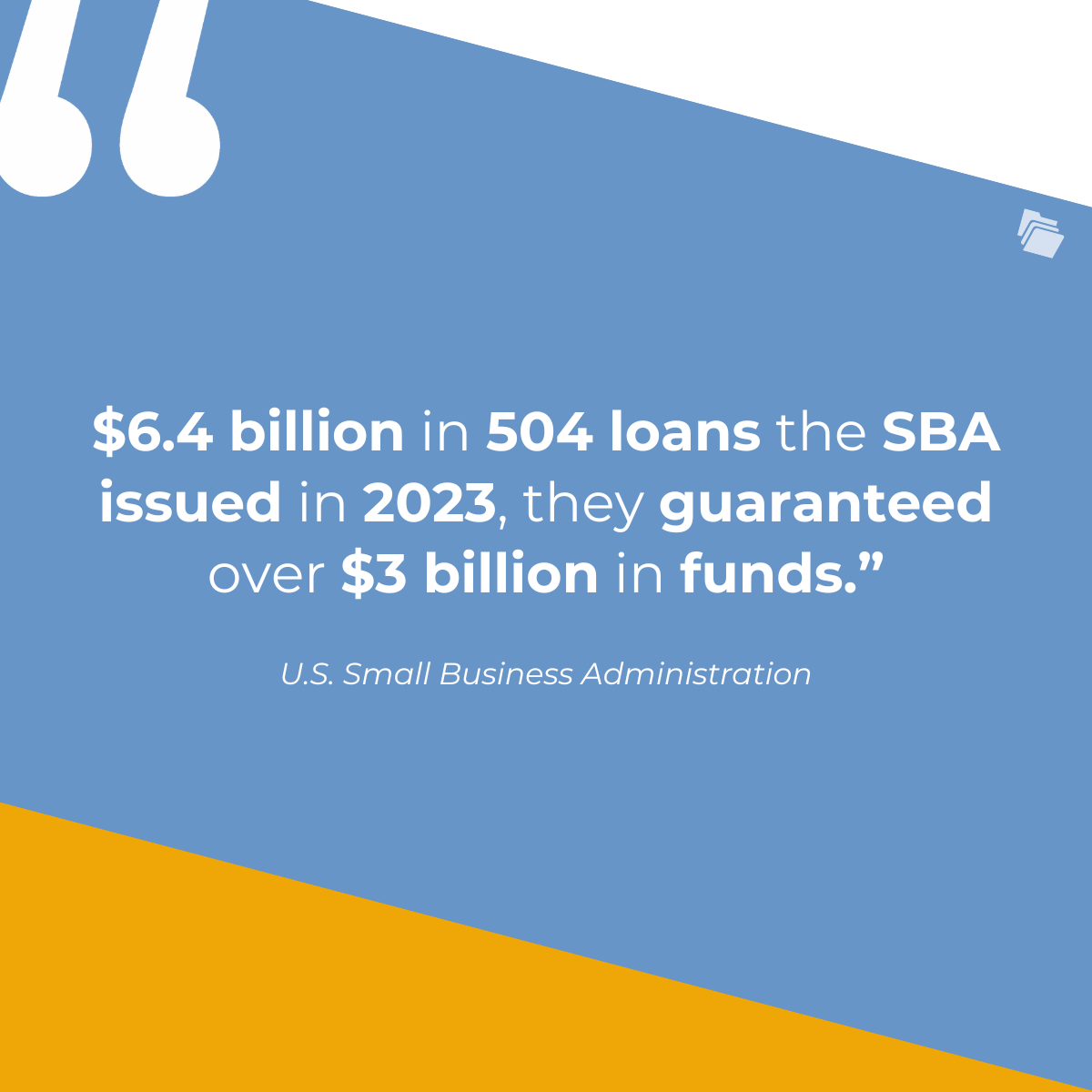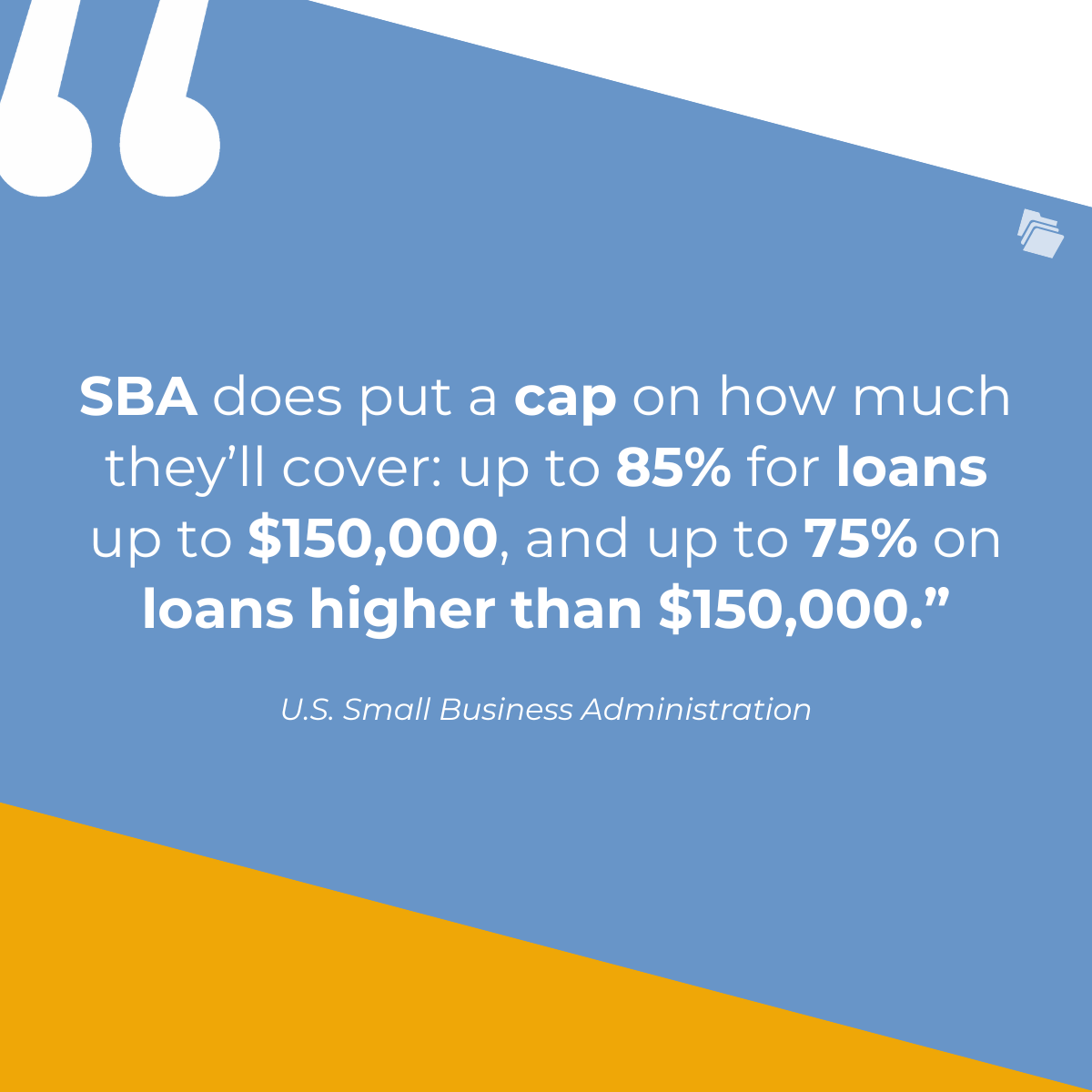SBA 504 loans are uniquely structured loans designed to help small businesses purchase or improve long-term fixed assets.
These loans are unique in several ways:
- Structure. While a typical loan only involves two parties—a borrower and a lender—SBA 504 loans involve a borrower, a lender (typically a bank or credit union), and a certified development company (CDC).
- Purpose. Small businesses can use their SBA 504 loan to purchase or upgrade long-term fixed assets within their organization—something we’ll explore in greater depth in a later section
- Guarantee. You may be wondering why a third entity is involved in SBA 504 loans and what purpose they serve. The CDC’s portion of the loan is guaranteed by the Small Business Administration (SBA), which is the central focus of this article. That means of the $6.4 billion in 504 loans the SBA issued in 2023, they guaranteed over $3 billion in funds.

It’s crucial that you properly and fully understand the SBA’s guarantee—what it means, what its implications are, and—just as importantly—what it does not mean.
In this article, we’ll go over the parameters of SBA loan guarantees, what they cover, and what they don’t, as well as provide some advantages and disadvantages of SBA 504 loans.
SBA 504 Loans are Guaranteed by the SBA
One of the key features that sets SBA 504 loans apart from other loan programs is that they involve a third party: a certified development company, or CDC. CDCs are non-profit organizations certified by the SBA, from which they receive a majority of their funding.
The lender typically provides 50% of the capital for the loan, a CDC provides another 40%, and the final 10% is provided by the borrower as a down payment.
What Does an SBA Guarantee Mean?
The Small Business Administration (SBA) guarantees the CDC’s portion of the loan. In other words, if the borrower defaults on the loan, the SBA will reimburse the bank for the portion of the capital the CDC provided—typically 40%.
For banks, this is a positive because it reduces their risk—they know at least 40% of the principal balance of the loan is “safe,” because if the borrower defaults, the SBA will cover that portion of the balance.
For borrowers, SBA 504 loans are positive because it gives them access to more capital than they would otherwise be eligible for.
For CDCs, their main goal is to strengthen the local economy through growing small businesses, so while they do earn revenue from the interest on the loan, their primary goal isn’t to turn a profit.
Conditions and Limitations of SBA Coverage
The SBA’s guarantee covers losses due to the borrower’s inability to repay, within certain parameters:
Due Diligence
Lenders are responsible for conducting due diligence on their borrowers. If they fail to conduct proper due diligence and end up making a loan to an uncreditworthy borrower, the SBA may not cover the CDC’s portion of the loan. The SBA’s guarantee is meant to shield the bank from mistakes made by the borrower, not from the underwriting process.
Limits
While the CDC’s portion is typically 40% of the principal, that is only a rule of thumb. The specifics of each loan can be negotiated within SBA guidelines, but the SBA does put a cap on how much they’ll cover: up to 85% for loans up to $150,000, and up to 75% on loans higher than $150,000. The SBA only covers the CDC’s portion of the loan up to those limits.

Qualifying Events
The main reason the SBA may have to step in to fulfill its guarantee is if the borrower defaults on the loan. This is a step further than simply missing a payment, but it isn’t the only situation that could lead to them paying out. If the borrower experiences bankruptcy or is engaged in material fraud, the SBA could similarly cover the CDC’s portion of that loan.
While the SBA’s guarantee is a huge advantage for both the borrower and lender, it isn’t purely altruistic. If a borrower defaults on their loan, triggering the SBA guarantee to pay out, that is not simply free money to the bank—the borrower is still responsible for repaying the entire balance of the loan, and the lender is still responsible for collecting repayment.
The SBA guarantee is not simply unconditional money, but a mitigation of risk for lenders.
Why SBA 504 Loans are Popular Among Small Businesses
SBA 504 loans are partially guaranteed by the SBA, but why would a small business seek out such a loan in the first place?
These unique financial products come with some unique advantages:
1. Lower Down Payments
The 10% down payment that borrowers are required to bring to the table is lower than many conventional down payments. Since the CDC’s contribution supplements the lender’s capital expenditure, the lender can accept lower down payments without taking on commensurate risk.
2. Long-Term Fixed Rates
Borrowers can obtain an SBA 504 loan at an increment above the interest rate for 10-year U.S. Treasury bonds. Given the 10-, 20-, or 25-year term lengths of these loans, this is considered to be a favorable interest rate.
3. Eligible Use of Funds
Perhaps the biggest advantage of any loan is simply the money—and the things borrowers spend it on. Small businesses can use SBA 504 funds to purchase or improve long-term fixed assets within their company. They could purchase a new piece of machinery, buy land to build a parking lot, or upgrade an existing piece of equipment. In 2023 alone, small businesses qualified for $6.7 billion in SBA 504 loans to invest in their long-term assets.
4. Guaranteed Security
Since the SBA guarantees the CDC’s portion of the loan, the bank faces less risk and borrowers receive access to more funds. That is why SBA 504 loans are such smart financial products—they can benefit both the borrower and the lender without creating undue risk for either party.
Drawbacks and Considerations of SBA 504 Loans
While SBA 504 loans are valuable tools, they do have a few drawbacks:
1. Limited Use of Funds
Since small businesses can only use SBA 504 funds to purchase or upgrade long-term fixed assets for their business, this excludes many of the expenditures businesses would like to use their funds on, such as buying inventory, paying payroll, or bulking up working capital.
2. Limited Negotiation
While some terms (like early repayment penalties and contribution percentages) can be negotiated between the three parties involved, many of the terms of the loan are set in stone by the SBA, such as the length of the term and the interest rate.
3. Eligibility and Documentation
Perhaps the biggest downside of an SBA 504 loan is simply the time it takes to obtain. In addition to the documents a lender would typically need to see to underwrite a loan, the SBA requires additional documents like personal tax returns and budgets going back multiple years. Collecting these documents can take as long as 6 months, though 2-3 months is more typical. To prove your eligibility for an SBA 504 loan, you must gather, process, and fill out a large amount of paperwork. This alone stops many applicants from obtaining funds.
Streamlined SBA 504 Processes with FileInvite
FileInvite's secure file sharing and document collection platform can substantially streamline the SBA 504 loan application and approval process for lenders. By automating the document collection process, FileInvite reduces the administrative workload involved in manually collecting, tracking, and storing documents. It enables lenders to send automated requests for documents and receive real-time updates when documents are submitted by applicants, ensuring no delays in the application process.
Moreover, FileInvite's centralized platform allows for easier collaboration among all stakeholders. It ensures that lenders, CDCs, and applicants can access the latest versions of documents, which helps in maintaining the integrity of the application process.
Importantly, FileInvite enhances compliance through its secure portal, which is designed to handle sensitive financial documents, providing both encryption and access control. This is crucial for maintaining the security of the applicant's personal and business information. By integrating with existing lender systems and offering a single portal for document management, FileInvite minimizes the potential for errors and omissions, leading to a more efficient approval process.
To learn more and request a demo, visit FileInvite today.

Related Posts: